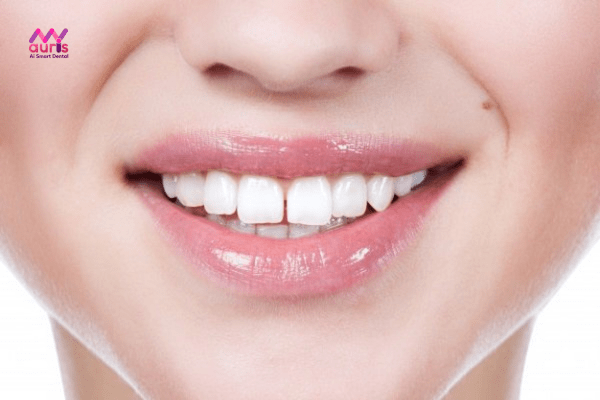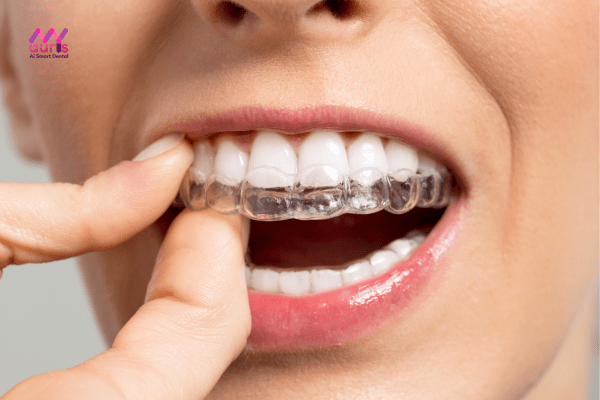Gap front teeth is also quite common. This condition is easy to see when the distance between the teeth is far apart and not close together. This not only causes loss of aesthetics and lack of confidence in communication, but also makes it difficult to chew and clean food. Because the gaps in the teeth are easy to stuff with food, if not cleaned thoroughly, it will be an environment for bacteria to grow and develop, causing diseases. Let’s learn with My Auris dentistry about braces for spaced front teeth to most effectively fix this condition.
What causes gapped teeth?
Gap teeth are also known as gapped teeth – this is a condition in which the two front teeth on the jaw do not grow fully or are not close together. This is very easy to see with the naked eye with symptoms such as the distance between teeth being too large, teeth being uneven, leading to a misaligned bite and affecting chewing function as well as difficulty in oral hygiene.

Causes of gapped front teeth
Sparse front teeth are not a rare condition. There are many reasons why front teeth grow apart such as:
- Small sized teeth: if the size of the two front teeth is too small, it will not be able to cover the empty area between the two teeth, leading to the two teeth being separated from each other, creating a gap.
- Permanent incisors grow in the wrong position, grow underground or pierce horizontally below the roots of the incisors instead of emerging from the gums. This causes the front teeth to separate and create gaps.
- Sparse front teeth are caused by genetics or congenital: if a family member has this condition, the next generation will have a high risk of having it.
- The front teeth grow in the right position and standard size, but the jaw is wide so it feels like the two teeth are separated and creating a gap.
- Misaligned incisors: when one or two incisors grow out unevenly, it will also lead to separation.
- Suffering from oral diseases such as gingivitis, periodontitis, receding gums, worn tooth necks, etc. are also the causes of sparse and gapped teeth.
- Due to bad habits: using toothpicks for a long time, using your tongue to push your teeth, sucking your fingers,… also cause the teeth to become clumpy.The mouth separates, creating a gap.

Whatever the cause of spaced front teeth is, it will cause loss of aesthetics and pose many other dental risks, so it needs to be restored as soon as possible. Among them, braces for gapped front teeth are the most optimal solution to help straighten teeth into the correct position and eliminate gaps between teeth.
Is braces for gapped front teeth effective?
According to doctors and experts, the best way to solve gapped front teeth is braces. However, for high efficiency, standard bite, and good correlation between the two jaws, braces must be performed on the entire jaw.
Braces by using specialized appliances such as brackets, wires, braces, etc. to create force to straighten teeth into the correct position, closely together according to the calculations of the treating doctor.
Rearranging the position of teeth also helps correct malocclusion between the two jaws. From there, the teeth will grow straight, evenly and closely together. This not only brings high aesthetics but also improves chewing ability and protects oral health.

And to be effective, braces will have to be applied to the entire jaw, in the case of braces on just two teeth, it cannot be straightened evenly and the gap cannot be fixed. space between teeth.
In addition, to effectively brace your front teeth and bring the desired results, go to a reputable, quality dentistry that ensures the doctor’s skills, expertise and experience.
What is the best method of braces for gapped front teeth?
Currently, there are 2 main methods of braces: braces braces and braces without braces (clear braces). Each method has its own characteristics. Depending on the level of tooth spacing, oral health, needs and economic conditions, the doctor will advise on the most suitable braces method.
Method to fix gapped front teeth with braces
Metal braces
This is the traditional type of braces, first used in orthodontics. The advantage of this type of braces is that they are durable, sturdy and easy to replace when they fall off. When starting, the doctor will install the braces on the tooth surface, then place the wire in the bracket groove and secure it with an elastic band. This method has low cost but brings good results. However, the biggest disadvantage is that it is unsightly and easily breaks the elastic, causing the brackets to easily come loose, interrupting the orthodontic process.
Ceramic braces
Ceramic braces are made from highly durable porcelain, safe for health, non-allergenic, non-irritating to the oral cavity environment. Ceramic braces are delicately designed, with honed edges so there is less friction, reducing pain, soft tissue damage and are especially more aesthetically pleasing than metal braces. Therefore, anyone who requires high aesthetics or often does work that requires meeting customers and communicating a lot should consider these ceramic braces.

Automatic braces
Automatic braces Can be made of metal or porcelain. The difference is that the braces are designed with an automatic opening and closing system that helps the wire slide freely in the bracket groove without using a fixed elastic band. Thanks to that, it minimizes bracket slippage, provides stable force, and extremely high brace efficiency, so braces time can be shortened. At the same time, arches limit pain, discomfort and entanglement more than traditional braces.
Method of braces for gapped front teeth using transparent braces
Transparent braces are also called are braces without braces or removable braces. Because orthodontic appliances are not fixed on the teeth but can be easily removed at any time.
Each person will have a different set of braces designed according to each person’s specifications. The braces are made from transparent plastic that hugs the dental arch, providing high aesthetics.
At the same time, braces still cause discomfort but reduce pain compared to braces. In addition to aesthetics, transparent braces also bring many advantages such as: easy cleaning, comfortable eating, knowing the results of braces in advance, reducing pain and entanglement, and saving time at the dentist.

Through the information in the article aboutbraces with gapped front teeth, people must have a better understanding of the condition as well as orthodontic methods. From there, consider the situation and choose the most suitable method. Please contact My Auris Dental immediately for the earliest advice and support regarding braces in particular and oral health in general.
Anh Thy





